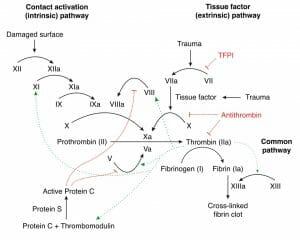Homeostasis refers to the steady state of internal conditions maintained by living organisms. Humans have control centers in the brain and other parts of the body that constantly monitor conditions like temperature, pressure, and blood and tissue chemistry. When any condition gets out of balance, feedback loops return the body to homeostasis. This is a natural response to changes in the optimal conditions for the body to function.
To sense when things are out of balance, bodily functions have set points around which normal values fluctuate within a range. For example, normal human body temperature set point is 98.6°F, and the range varies a few degrees above and below that. There are positive and negative feedback loops in physiological processes that react when conditions venture outside the range.
Feedback loops have three components—the sensors, the control, and the effector. Sensors are also called receptors and they monitor conditions inside and outside the body. Some examples are thermoreceptors and mechanoreceptors. The control center, often in the brain, compares the value the sensor receives to the values in the range. Finally, the effector is what the feedback loop acts on.
Negative Feedback Loops
In the human body, this kind of feedback loop acts to resist or reverse the process when conditions go outside of the range.
Body Temperature
Core body temperature in mammals is regulated by thermoreceptors in the hypothalamus in the brain, spinal cord, large veins, and internal organs. When the core temperature gets too high, the animals first reaction is usually behavioral thermoregulation, also called allostasis. The animal may seek shade to get out of the sun or move into the water to cool its skin. This type of thermoregulation is the primary reaction because the effects will occur faster than the physiological mechanisms. It is important to realize that this feedback mechanism is based on controlling heat loss or heat gain in the body. The body does not “cool itself” in the literal sense, meaning it does not turn on an internal air conditioning system or synthesize chemicals that cool the body.
The major thermoregulatory negative feedback loop for cooling is when thermoreceptors on the skin detect higher than desired temperatures. This stimulates cholinergic sympathetic nerves to activate sweat glands in the skin to secrete sweat which evaporates and cools the skin and the blood in the vessels running through it. In animals like dogs and cats that have no sweat glands, the allostatic response is panting through the mouth to increase heat loss from the lungs. The stimulation of the sympathetic nerves decreases as the core temperature lowers back to the normal range.
If the core temperature becomes too cool, the first response is usually shivering (the allostatic response). Physiologically, the thermoreceptors trigger vasoconstriction in the skin and also reduces the flow of blood to the limbs. This moves more blood to the trunk of the body via the deep veins. In the trunk there is a counter-current exchange system where the veins run alongside the arteries, transferring some heat from the arterial blood to the venous blood.
Other examples of negative feedback loops include the regulation of blood sugar, blood pressure, blood gases, blood pH, fluid balance, and erythropoiesis.
Positive Feedback Loops
Instead of reversing it, positive feedback encourages and intensifies a change in the body’s physiological condition, actually driving it farther out of the normal range. This type of feedback is normal for the body, provided there is a definite endpoint.
Blood Clotting
The process of blood coagulation (hemostasis) is a cascading positive feedback loop. When the body is damaged inside or outside, the damaged tissues release factors that cause platelets to adhere to the tissue (the effector) at the site of the wound. The platelets release granules that activate and attract more platelets and cause them to bind to each other. Fibrinogen is converted to fibrin which creates a meshwork that traps blood cells and platelets, forming a clot and stopping the bleeding. The cascade comes to an end when thrombin binds to the cofactor thrombomodulin, activating protein C which inhibits the coagulation cycle.
Chemically, the activation of the enzyme prothrombin into its active form thrombin is one step in the clotting process. But what makes this a positive feedback loop is that thrombin can also activate the coagulation factors that precede it in the cascade. In other words, an increase in thrombin leads to a greater increase in thrombin. Figure 1 shows how thrombin regulates its own generation by activating clotting factors V, VIII, and XI.
Childbirth
Once labor begins, it is critical the process proceed quickly, or the life of the mother and baby will be at risk. The cascade of muscular events involved in labor and delivery are the result of a positive feedback system which is designed to do this.
The stimulus for the process to begin is the first contraction of labor. As the baby is pushed toward the cervix by the powerful contractions of the uterus, stretch sensors in the uterus monitor how much the cervix stretches. The sensors send messages to the pituitary gland in the brain, causing it to release the hormone oxytocin into the mother’s bloodstream. Oxytocin acts on the smooth muscle cells of the uterus (the effectors) causing stronger contractions, moving the baby farther down the birth canal. This continuous cycle of stretching and releasing of oxytocin stops only when the baby is expelled from the birth canal (the endpoint).
References
- OpenStax College. (2018). Anatomy & Physiology. Houston, TX. OpenStax CNX. Retrieved from http://cnx.org/contents/14fb4ad7-39a1-4eee-ab6e-3ef2482e3e22@8.119
- Homeostasis. (n.d.). In Wikipedia. Retrieved March 30, 2018 from https://en.wikipedia.org/wiki/Homeostasis
Positive and Negative Feedback Homeostasis

No comments:
Post a Comment